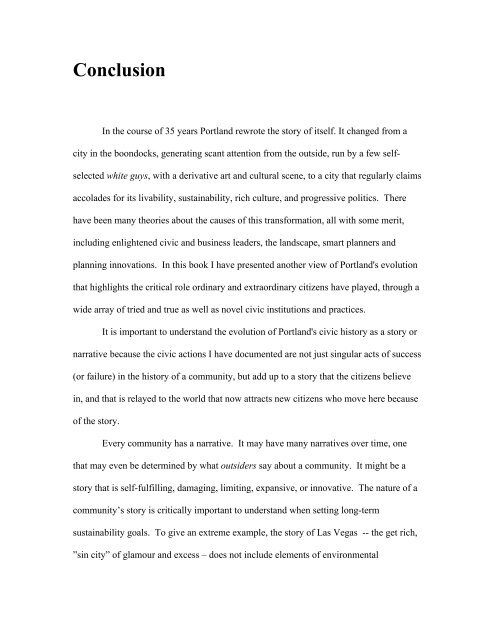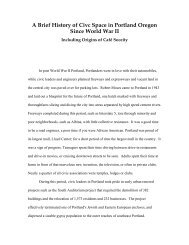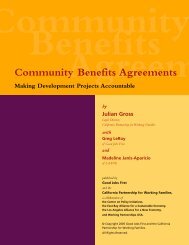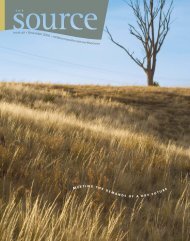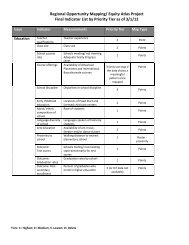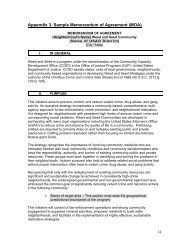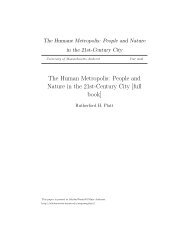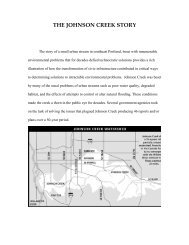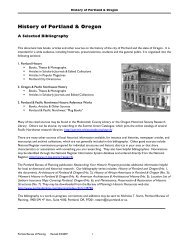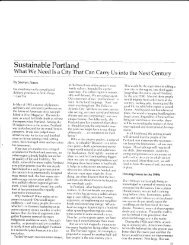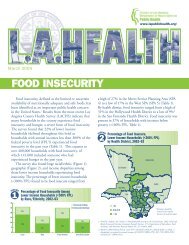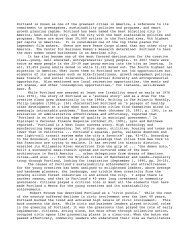Conclusion - Steven Reed Johnson
Conclusion - Steven Reed Johnson
Conclusion - Steven Reed Johnson
Create successful ePaper yourself
Turn your PDF publications into a flip-book with our unique Google optimized e-Paper software.
<strong>Conclusion</strong><br />
In the course of 35 years Portland rewrote the story of itself. It changed from a<br />
city in the boondocks, generating scant attention from the outside, run by a few selfselected<br />
white guys, with a derivative art and cultural scene, to a city that regularly claims<br />
accolades for its livability, sustainability, rich culture, and progressive politics. There<br />
have been many theories about the causes of this transformation, all with some merit,<br />
including enlightened civic and business leaders, the landscape, smart planners and<br />
planning innovations. In this book I have presented another view of Portland's evolution<br />
that highlights the critical role ordinary and extraordinary citizens have played, through a<br />
wide array of tried and true as well as novel civic institutions and practices.<br />
It is important to understand the evolution of Portland's civic history as a story or<br />
narrative because the civic actions I have documented are not just singular acts of success<br />
(or failure) in the history of a community, but add up to a story that the citizens believe<br />
in, and that is relayed to the world that now attracts new citizens who move here because<br />
of the story.<br />
Every community has a narrative. It may have many narratives over time, one<br />
that may even be determined by what outsiders say about a community. It might be a<br />
story that is self-fulfilling, damaging, limiting, expansive, or innovative. The nature of a<br />
community’s story is critically important to understand when setting long-term<br />
sustainability goals. To give an extreme example, the story of Las Vegas -- the get rich,<br />
”sin city” of glamour and excess – does not include elements of environmental
sustainability such as the carrying capacity of the Colorado River, etc. Portland’s story,<br />
by contrast, even if part myth, is about environmental sustainability and public<br />
involvement. The story is a construction of social knowledge: part rational science, part<br />
experiential knowledge. A healthy civic story will lower the cost of governance by<br />
spreading the responsibility for maintaining the commons between citizens, NGOs, and<br />
the private and pubic sectors. Much as Native American stories taught their people about<br />
sustaining the natural world for future generations, a good community story is one that is<br />
environmentally, economically, and socially sustainable. The goal of the best kind of<br />
community story is to maintain or restore an habitation pattern that is sustainable.<br />
Bradshaw Hovey, in an article in the journal of Utopian Studies, says that, within<br />
the planning profession, and beyond, Portland is seen as a practical demonstration of how<br />
good planning, effective citizen participation, and regional growth management can<br />
produce what is commonly referred to as a good "quality of life." While this part of the<br />
Portland story is well known, Hovey's understanding of the role of story, as a tale<br />
developed and told by the residents of a community, is important to understanding the<br />
thesis of this work. Hovey (1998) says:<br />
It is important to keep in mind that Portland's story about itself--or any community's<br />
story about itself--is more than a concatenation of events, outcomes, and key<br />
players. In Portland's case, at least, it is also partly a myth or legend which carries a<br />
message about what kind of people Portlanders are, what the community values and<br />
what it opposes, about the right and the wrong way to do things in Portland, what it<br />
means to be a member of the community, and ultimately, what kind of a city they<br />
collectively wish to be. (p. 69)
It is important that we get the story, or history of our place, correct for the sake of<br />
the historical record, but it is also important because it provides a blueprint for how<br />
change takes place. Too often the story we know is based on regimes of electoral politics<br />
or the impact of key leaders. While these stories may have validity, they also diminish<br />
the importance of individual, lesser known citizens and the role of an active citizenry. If<br />
we collectively believe that contributions to civic life and change are implemented by<br />
leaders then we may falsely assume that power only resides in a few gifted individuals or<br />
individuals with inherited social capital or financial resources.<br />
It is also true that without leaders, such as Neil Goldschmidt (Mayor of Portland,<br />
1973--1979) and Tom McCall (Oregon Governor 1967—1975) these civic innovations<br />
may never have taken hold or had as much impact in the community. This points to the<br />
symbiotic relationship that exists between leaders and citizens. A healthy civic life is<br />
dependent on both.<br />
Portland's exemplary civic path may be explained by its ability to generate civic<br />
innovations. While the civic order was in upheaval, as clearly indicated first by social<br />
movement unrest in the late 1960s and early 1970s and then by a dramatic organizational<br />
ecological shift that followed, the emergent political leadership of Portland took<br />
advantage of the rising tide of civic activism. Rather than resisting the new forms of<br />
collective behavior, they incorporated the activists into a larger civic umbrella. This study<br />
confirms Sirianni and Friedland’s (2001) thesis that civic innovations in many<br />
communities around the country emerged from the initiative of state actors and were<br />
sustained through governments working with committed professional community<br />
advocates and citizen groups.
In the 1950s and before, citizen involvement in Portland meant bringing together<br />
the usual cast of elected officials and civic elite. After the reconstruction period in the late<br />
1960s and early 1970s, Portlanders learned to expect much more—not just to elect<br />
politicians to represent their interests but to be provided the opportunity to be involved in<br />
public policy on an ongoing basis.<br />
In 1960, the City of Portland budget reflected only one position at all involved in<br />
citizen participation, an outreach worker for the newly formed Portland Development<br />
Commission. Today public involvement is a core service of the City. The most obvious<br />
nexus is Portland’s 30-year-old Office of Neighborhood Involvement. In 2002, this<br />
office had a $8-million budget, at least $1.2 million of which focused on direct<br />
involvement of citizens in public policy issues. But public involvement is also dispersed<br />
throughout the bureaus of the City. In one recent study conducted by the City to find<br />
ways to cut costs, 122 staff were described as public involvement positions, amounting to<br />
$8 million in general operating fund expenditures (Brian Hoop, personal communication,<br />
January 2003).<br />
The change agents in the late 1960s and early 1970s were not always greeted with<br />
open arms. Hundreds of activists were stalked by the Police Bureau’s secret subversive<br />
watch program. Activist, Tom Walsh (in 1999 director of the metropolitan transit<br />
organization, TriMet) was referred to as the “king of the hippies.” In the early 1970s,<br />
downtown business interests were focused on increasing parking in downtown and<br />
showed only moderate interest in plans to create Pioneer Place, a public space now<br />
thought of as Portland’s living room. Likewise, civic elites like Ira Keller had little<br />
interest in preserving neighborhoods such as Lair Hill which he described as, “just
awful—like something you’d find in the Tennessee mountains. It’s worse than Albina<br />
(Urban renewal project, p.5).” At that time, in a dramatic error of judgment with<br />
cascading consequences, including the genesis of Portland’s neighborhood movement,<br />
the City and PDC did not feel compelled to have much contact with residents about the<br />
future of that neighborhood.<br />
The transformation of civic life in Portland since the 1950s was shaped by wave<br />
after wave of challenging groups, the mobilization of constituencies that often coalesced<br />
as issue interest groups or whose agendas were institutionalized as formal government<br />
programs. At any given time, the organizational form taken by the mobilization depends<br />
on the existing civic infrastructure, the repertoire of actions that are available and<br />
effective, and the encouragement or flexibility of the established political powers. The<br />
formation of new groups to challenge the status quo or bring innovative new ideas to the<br />
forefront is an essential democratic civic act.<br />
There are many stories throughout this study of the catalytic innovations of<br />
everyday citizens and grassroots organizations and collective actions. Portland’s<br />
citywide neighborhood system was signed into law by Mayor Goldschmidt, but it was<br />
inspired by the collective actions of countless citizens who resisted freeways and<br />
demolition of neighborhoods. Portland’s radical departure from building freeways to<br />
investing in light rail can be traced to a handful of individuals in southeast Portland who<br />
stopped the Mt. Hood Freeway. The revitalization of downtown would have played out<br />
very differently without citizens like Betty Merten, who disagreed with the business<br />
leaders in the early 1970s who wanted more parking in downtown. Without Waterfront<br />
for Citizens there might be a freeway along the Willamette River in downtown instead of
a Portland’s premier civic event area, Waterfront Park. The resettlement of Portland’s<br />
inner city neighborhoods, such as Irvington in northeast Portland and the Lair Hill and<br />
Corbett Terwilliger neighborhoods in southwest Portland, were first resettled in the late<br />
1960s and 1970s by impoverished students and idealists, such as the members of<br />
Terrisquirma and The Learning Community. The creation of Portland’s first community<br />
development corporations and an affordable housing movement can be traced back to a<br />
community congress organized by citizen activists. The creation of a Portland-region<br />
wide greenspaces program and the movement to restore Portland area watersheds and<br />
wetlands was initiated by activists using state-of-art computer mapping technologies and<br />
street theater actions to draw attention to the value of green infrastructure. Portland’s<br />
reputation as a city with a green or sustainable development outlook can be traced to<br />
grassroots collective actions. For example, Portland’s highly developed recycling<br />
programs started with the “hippie” efforts of Sunflower, Cloudburst, and Portland<br />
Recycling Team. The Pacific Northwest sustainable agriculture and natural foods<br />
movement dates back to Tilth’s convocation of sustainable agricultural activists in the<br />
early 1970s. The region’s movement away from fossil and nuclear fuels to soft energy<br />
options would probably not be so advanced without education and activist groups such as<br />
Rain and Sun.<br />
Civic Infrastructure<br />
I have examined Portland's civic history since World War II using both a<br />
chronological and thematic approach. The historical approach illuminates the decisive
moments and collective actions that created the civic Portland of today. The examination<br />
of Portland's civic infrastructure provides a way of evaluating the health of civic life. I<br />
do not contend that my analysis represents a completed theory or approach. It is a work<br />
in progress. However, some of the most important elements have been revealed.<br />
Opportunity and efficacy<br />
Citizens need opportunities to be involved. In Portland, the opportunities are<br />
numerous and widespread; but opportunity needs to be accompanied by investment in the<br />
human capital of citizens. If citizens have opportunity to be involved in local decisionmaking,<br />
planning, and public policy, but do not have civic skills and knowledge to be<br />
effectively involved, then the bureaucrat’s nightmare of time and cost delays and policy<br />
gridlock may come to pass.<br />
In Portland, traditional civic life declined because traditional groups either died or<br />
became irrelevant. Less than 20% of the civic groups of the 1950s were still in existence<br />
in 2000. Over time, they either failed to be inclusive, adaptive, or innovative, and, at<br />
some point, no longer served as the sources of civic skills and knowledge acquisition for<br />
citizens desiring to effectively participate in the civic life of the community.<br />
Information, thanks to the Internet, about community affairs is much more readily<br />
available. But, information alone isn't sufficient. Citizens have to know how to use the<br />
information, and they need civic skills such as how to facilitate participatory group<br />
process, or present public testimony. Additionally, there is a values question. If citizens<br />
are empowered, for example through a structured and empowered neighborhood
involvement system such as Portland's, to represent their own self interest or only their<br />
immediate neighbors, without a broader or deeper understanding of city-wide, regional,<br />
or even global interests and perspective, then the result can be an over-articulated civic<br />
arena.<br />
Engaged schools and universities<br />
The civic health of a community depends on an education system that nurtures<br />
good citizens as well as wage earners. It is a public good that lowers the cost of<br />
governance. One promising direction in civic education is Portland State University’s<br />
(PSU) community-based learning curriculum. Every year, 8,000 students work in the<br />
community, selecting from 1000 different community partners. At the heart of this<br />
innovative curriculum is learning, not volunteerism. When graduates of PSU are asked if<br />
they plan to continue their engagement, the strongest determinant is their sense of<br />
efficacy, i.e. whether what they did made a difference. This need for efficacy was<br />
tempered by the degree to which they felt trust in public institutions. If trust and efficacy<br />
were lacking, then students tend to look out only for themselves, leaving the work of<br />
protecting the commons to someone or something else (Morgan and Williams 2003).<br />
Facilitative leadership style
Portland's civic renaissance was fueled by a symbiotic relationship between citizens<br />
and government. The leadership in Portland during the early 1970s, and at several points<br />
since then, has been more facilitative than paternalistic. Universities also have a key role<br />
in maintaining a healthy civic infrastructure by virtue of nurturing public servants who<br />
know how to facilitate effective citizen involvement. Today’s public servants or<br />
bureaucrats need a new suite of skills and knowledge that allow them to tap the<br />
“wisdom” of citizens. Typical graduates of universities come away with specialized<br />
knowledge, but often lack the skills and knowledge to work with citizens. An engineer<br />
may know how to build a road, but not how to work with community members to build<br />
roads that meet a multitude of livability goals citizens deem important.<br />
Civic space<br />
Civic spaces are an extension of the community. When they work well, they serve<br />
as a stage for our public lives. If their civic role is functional, civic spaces can be the<br />
settings where celebrations are held, where exchanges both social and economic take<br />
place, where friends run into each other, and where cultures mix. When cities and<br />
neighborhoods have thriving civic spaces, residents have a strong sense of community.<br />
When such spaces are lacking, people may feel less connected to each other. If civic<br />
spaces are inadequate, civic life, including citizen participation, will suffer. If urban<br />
design emphasizes gated communities and private or semi-private spaces over public, and<br />
does not include plentiful locales where people can mix across class or cultural<br />
boundaries, then, when citizens must come together to solve community problems, it will
e much more difficult.<br />
One Shoe Does Not fit All<br />
In Portland there are many types of citizens, and many type of citizen-based<br />
organizations. The boundary between private citizen, NGO staff, volunteers, local<br />
government bureaucrats, and elected official, meanders. During the Popular Pluralist<br />
period, the Mayor, Bud Clark came up from the ranks as both the owner of a popular<br />
third Place, the Goose Hollow Inn, and as a board member of a neighborhood association,<br />
while the coordinator of the neighborhood district office where the Mayor lived,<br />
Margaret Strachan, became a city commissioner. The most recent female city<br />
commissioner, Amanda Fritz, got her feet wet so to speak, as a watershed restoration<br />
activist. Additionally, many of the City of Portland advocate bureaucrats were first NGO<br />
staff members or volunteers.<br />
There are in Portland, and most any community, what I've come to call<br />
professional citizens, those that meander across these boundaries, and dedicate their life<br />
through paid and voluntary positions, to being effective citizen advocates. These are the<br />
citizens often appointed to advisory groups because of their high level of skill and<br />
knowledge about public processes and specialized knowledge of an issue, e.g.<br />
transportation planning, health care, etc. The commitment of these “professional”<br />
citizens is substantial. An appointment to a citizen advisory committee might last<br />
months, even years, and involve frequent meetings, a substantial commitment to learning<br />
technical information, and the willingness and ability to mediate with other stakeholders
over contentious issues. This tier of public involvement plays a vital role in the health of<br />
a community’s civic life. “Professional” citizens provide knowledge and perspectives<br />
because of their day-to-day work within interest groups or NPOs that extends the<br />
capacity of local government agencies. While these citizens often provide valuable and<br />
objective information to the local public policy debate, they may also have invested<br />
interests and be a part of the establishment in ways that your average citizen are not.<br />
Beyond the tier of the truly dedicated citizens there are occasional citizens, who<br />
may not have the time or dedication that professional citizens have, but are as centrally<br />
important. Their involvement in civic life is not as easily assured. To involve this<br />
broader base of citizens a community needs a constantly changing suite of public<br />
involvement processes and tools. Civic innovations, such as citizen juries, community<br />
benefit agreements, appreciative inquiries, and issues forums, need to be explored and<br />
implemented to continually involve the broader spectrum of citizens, and to keep the core<br />
of professional citizens from thinking too much alike.<br />
The Demographics of Public Involvement<br />
groups.<br />
A healthy civic infrastructure also needs to make room for a variety of population<br />
The Young--Public involvement institutions and practices need to evolve to<br />
accommodate the culture of the young. The collapse of traditional civic life in Portland’s<br />
history reflects this need. When the established civic institutions refused to<br />
accommodate the new ways of the young –the baby boomer “graduates” of the social
movements of the 1960s – those young people created their own institutions that, over<br />
time, replaced many of the traditional ones. These “boomer” institutions may themselves<br />
be challenged by today’s youth, especially the “digital natives” who grew up immersed in<br />
global electronic media. These digital natives may be impatient with old style face-toface<br />
involvement such as neighborhood meetings.<br />
Elder--At the opposite end of the age spectrum are the elders of a community, now an<br />
especially large number with the graying of the baby boomer generation who possess<br />
both wealth and slack resources. Elders need to be incorporated effectively into civic life,<br />
and efficacy is the key word here. Elders’ place at the civic table should not be a purely<br />
honorific one. As with any society, there needs to be a means to transfer wisdom.<br />
Wisdom involves a longer civic narrative timeframe that can be difficult to incorporate<br />
into everyday civic life. There is an alarming distancing of young and old activists due<br />
to the differential use of the Internet by the young and old for civic involvement.<br />
New comers--One of the challenges for many communities, including Portland, is the<br />
inclusion of increasing numbers of newcomers from other states and nations. How can<br />
the civic narrative and infrastructure adapt to incorporate these groups Many<br />
immigrants to the Portland area have been drawn by the story or myth that the city has<br />
created, but they may not understand the elements of this story as translated into rules,<br />
regulations, policies, and mores. Then there are the many newcomers who arrive without<br />
much knowledge at all of the prevailing narrative. In effect, the community needs a<br />
“welcome wagon” process to enroll people into the community’s storyline while also
continually adapting the storyline to new input and perspectives.<br />
Disadvantaged--A community, like society, is, as Martin Luther King said, judged by<br />
how well it treats its most disadvantaged. The disabled, poor, and minorities demand<br />
unique and innovative venues for effective public involvement. What may be underappreciated<br />
is just how many may see themselves as “disadvantaged.” A robust public<br />
involvement process is multi-leveled and flexible, accommodating people who are better<br />
at writing than speaking, those who think in terms of stories rather than numbers, and<br />
those who learn by doing as well as by studying manuals and policy documents.<br />
challenging groups--One of the clear historical lessons from Portland’s civic story is that<br />
because the established order of civic institutions closed the door to young people in the<br />
late 1960s and early 1970s, the young created new civic institutions. The “insiders” did<br />
not listen to the new challenging groups, let alone learn from them or alter their<br />
institutions or civic actions. As a result, the older institutions began losing members, and<br />
the attention of the community.<br />
Diverse population--A civic infrastructure that includes a diversity of perspectives is<br />
good and just, but there are more important reasons to advocate for diversity in public<br />
involvement venues. As Surowiecki (2004) argues in The Wisdom of Crowds, diversity,<br />
along with independence and decentralization, are the three basic elements that allow for<br />
the wisdom of groups to emerge. In several examples, he illustrates that groups made up<br />
of only “smart” people don’t come up with the best solutions to problems. If you
assemble a diverse group of people who possess varying degrees of knowledge, you're<br />
better off entrusting major decisions to them rather than to only one or two people, no<br />
matter how smart. The more influence we exert on each other, the more likely we will<br />
believe the same things and make similar mistakes. Diversity contributes not only<br />
additional perspectives; it is also easier for individuals to say what they truly think.<br />
Why is it Important<br />
The complex suite of issues we must address to reach environmental and social<br />
sustainability at the community level necessitates a community governance structure that<br />
harnesses the wisdom of a broad cross-section of its citizens, the “wisdom of crowds, or<br />
wisdom of citizens." Portland's civic history over the last thirty years reveals how when<br />
civic leaders and advocate bureaucrats are able to facilitate the wisdom of its citizens, a<br />
community can solve some, not all, intractable community problems. Portland's form of<br />
community governance may provide a model for the future when citizens will have to be<br />
routinely involved in creating socially and environmentally sustainable communities.<br />
A metaphoric way of understanding this form of community governance is to<br />
think of the hardware and software components of a community. Public and private<br />
sector players have build America, at least until recently, using a hardware model, large<br />
public works enterprises, such as roads and sewers. These still need to be constructed,<br />
and engineers will still have jobs, but some of the solutions to community problems are<br />
software problems. For example, municipal waste was addressed by creating ever better
incineration technology. Today, citizen involvement in recycling is an essential part of<br />
the solution and could be called a “software” solution. Or consider the issue of stream<br />
pollution: the old government structure could deal fairly handily with “point pollution”—<br />
pollution that had a single source. One located the source and remedied the situation by<br />
working with the single polluter. Non-point pollution, by contrast, is caused by the<br />
actions of thousands of residents in a watershed. Facilitating the solution to non-point<br />
pollution requires a very different approach and leaders and bureaucrats who have the<br />
ability to facilitate collective responses. To solve community issues from a long-term<br />
sustainability perspective, then, we need to move from “hardware” to “software”<br />
solutions. Other examples would include community policing and neighborhood watch,<br />
flex car options and car pooling, tool lending libraries, and providing some forms of<br />
health through maintaining and enhancing social support networks.<br />
Challenges for Portland<br />
Civic life in Portland, as in most communities, is increasingly influenced by and<br />
conducted online. Citizens are also turning to the Internet to obtain government<br />
information. 97 million or 77% of internet users have gone online to search for<br />
government information and to communicate with government agencies. Portland is<br />
considered to be one of the more wired communities in the country. An August 18, 2005<br />
front page story in The Oregonian reported that “Portland’s drive to take the internet out
of the office and into the streets has won a high-profile endorsement from Intel, which<br />
named the city one of America’s most technologically advanced." The digital natives,<br />
those who can't remember a time without the Internet, take to the new civic life, like<br />
sixties social movements took to the street, creating blogs, online electoral and issue<br />
campaigns, and novel uses of social networking space. But, there is a considerable gap<br />
between the aging activists and the young. A difference in discourse and organizing<br />
venue that needs to be bridged.<br />
For the health of local civic life, the Internet poses a local-to-global set of<br />
problems. As Robert Putnam noted, “Technologies like the Internet mean that our<br />
connections with people around the country and around the world are getting closer,<br />
while our ties to our neighbors across the street are weakening” (Putnam 2002). Citizens<br />
access more national news online than local, and some evidence suggests that long<br />
distance social networks are strengthened at the expense of local social networks.<br />
In terms of the quality of democratic dialogue that takes place on the Internet, in<br />
particular in the “blog world,” Stephen Bates at the Annenberg School of communication<br />
notes that the Internet prompts more knee-jerk reactions than deliberative responses . He<br />
goes on to note that "when there is more interesting discourse, you can tell it's people<br />
who just love to hear the sound of their own voices. They're not really listening to other<br />
people. It gives people a way to respond instantly and often angrily and aggressively<br />
without taking the time to mull something over."<br />
The very nature of organizations and how individuals relate to one another is<br />
being changed by the Internet. Some trends impacting local civic life include: the fluid<br />
nature of organizational membership; an increase in intra-organizational membership;
and "membership" in organizations online that solidifies affinity groups at the expense of<br />
exposure to different perspectives. There may also be an increase of expressive forms of<br />
citizen participation at the expense of more deliberate dialogue, while at the same time<br />
individuals may gain more power as individuals and be able to foster weak ties at a<br />
distance.<br />
Though Putnam has thoroughly documented the decline of civic life in America, it<br />
is sometimes forgotten that his critique is not solely about the declining number of<br />
citizens involved, but also the nature of that involvement. He noted that collective action<br />
has declined more rapidly than expressive forms of individual action (e.g. letter writing).<br />
"There is," he said, “more single issue blare and declining civility (Putnam 2000, p. 46).”<br />
In the Wisdom of Crowds, Surowiecki (2004) points out some key distinctions<br />
between “wise” crowds and unruly mobs. It is not enough just to ask for citizens<br />
opinions; the communication process has to be structured to gain the generalized wisdom<br />
of the citizenry. We too often confuse opportunity for citizens to publicly express their<br />
opinion with true and effective citizen participation. Fortunately, there are a growing<br />
number of practitioners and theorists who are developing deliberative democratic<br />
processes to capture the wisdom of citizens. Communicative planning theory promotes<br />
citizen participation in which knowledge is socially constructed. Participatory research<br />
focuses attention on the need to include citizens early in any process when the ground<br />
rules, original questions, data selection, and analysis typically narrow the scope for<br />
participation into simplistic choices between limited number of options. Other civic<br />
process models attempt to balance power differences and make use of different types of<br />
knowledge. For example, Participatory rural appraisal--ways of utilizing local
knowledge and analyzing and including that “data” in assessments and implementations,<br />
and Beneficiary assessment – processes that focus on experience of the recipients or<br />
those effected – are two examples. Organizations such as the Kettering Foundation,<br />
Center for Deliberative Democracy, and the American Democracy Project have<br />
developed creative processes to involve citizens in substantive dialogues rather that<br />
rudimentary public processes like public hearings.<br />
Portland has built an exceptional civic infrastructure over the last 40 years, but as<br />
the city enters the 21st century the next test will be whether the collective vision can hold<br />
steady with a more diverse population, the divisive tactics of special-interest-group<br />
politics, and a civic life that is carried out as much in the virtual blogsphere as it is in<br />
face-to-face neighborhood meetings. The ferment of civic activism of the previous<br />
generation has changed both the “vocabulary” and “grammar” of civic life–-the goals and<br />
values that are commonly accepted and the ways that decisions are made. If this is true,<br />
Portland represents a challenge not only to Putnam’s thesis of a decline in civic<br />
participation but also to his worry that such declines erode the shared goals and patterns<br />
of trust that are often called “social capital.” Structural explanations do not seem to<br />
clarify Portland’s rich civic life. Portland is quite similar to Seattle, Denver, Austin, and<br />
Columbus in demographic structure and economic base, but it ends up with a very<br />
different style of public life. What does seem to account for Portland’s distinctiveness is<br />
learned behaviors. Early successful examples of participatory action encouraged other<br />
activists and bred institutions that in turn embedded and reinforced particular styles of<br />
action. In effect, Portlanders in the last 35 years have learned about the rewards and<br />
problems of active citizenship through practice. Nevertheless, the underlying challenge
for progressive Portland is whether the efflorescence of civic activism will be limited to a<br />
single generation. In places such as Birmingham and Chicago, the “civic moment” faded<br />
after a few decades as problems seemed less urgent. New groups with new issues did not<br />
find the progressive consensus open to their concerns and had little interest in celebrating<br />
past accomplishments.<br />
Will Portland’s habits of planning and a larger habit of civic activism carry its<br />
own momentum Will newcomers care to learn the Portland style Can a particular<br />
political culture or style be transmitted across generations Will the institutionalizing of<br />
activism perpetuate or dampen the fervor of reform Is the civic infrastructure created<br />
since the 1960s robust enough to accommodate the interests and needs of a changing<br />
community Will what Putnam calls the “Portland anomaly” fade or continue in the 21 st<br />
century (<strong>Johnson</strong> and Abbot, 2003).<br />
It is necessary to develop more effective ways of engaging people in community<br />
problem-solving in partnership with government and that requires a software solution that<br />
harnesses the wisdom of a diverse cross-section of citizens. The complex problems we<br />
seek to resolve demand “face time” that enables citizens to strengthen social capital and<br />
bridge disparate communities and perspectives. We also need to understand and access<br />
the capacities that the revolution in information technology provides. One need only<br />
spend time perusing the first encyclopedia on the planet created by everyone rather than a<br />
handful of experts – Wikipedia – to understand the potential of global “idea agoras” and<br />
“wisdom of crowd” software. Remember, on the popular television show, “So You Want<br />
to be a Millionaire,” the audience is right 91% of the time. And the “experts” They<br />
clock in at 65%.


